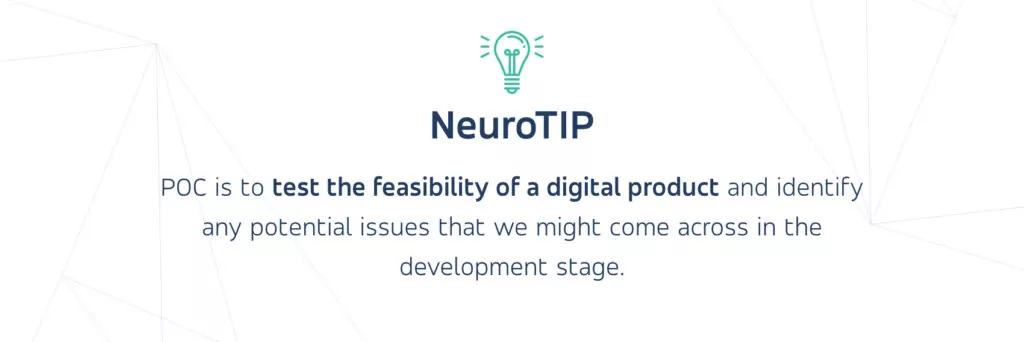When you’re setting up your digital product, you might be sitting on the fence, trying to decide how to do it. Should I build an MVP, a prototype, or aim big and develop a fully functional product? Where to start? What technology to choose? Are my goals achievable at all?
Today we’d like to show you how the smallest end product, even smaller than MVP, can work when you build an application that is to break new grounds. This item is POC.
What is a proof of concept? The definition
A proof of concept (POC, PoC) is a method adopted in a lot of industries and areas, such as manufacturing or drug discovery. In software development – it is to test the feasibility of a digital product or new major functionality to be built. Its main aim is to prove whether our idea is viable, especially from a technological standpoint, before we decide to make any heavier investments.
To do that we build the first working interactive model with almost all functionalities to visualize how they will work. It is aimed to be temporary and written as quickly as possible, not focusing on detail or beautifully crafted. It won’t, as opposed to an MVP, be shown to any broader audience.
POC allows us to identify any potential issues that we might come across in the development stage and, most importantly, whether it is viable to build at all. POC doesn’t focus on market demand or end-users.

When POC has a sense
Building a proof of concept makes sense only when we’re developing a product that breaks new ground or in problematic functionalities and daunting tasks that require innovative approaches.
We don’t build it when there are plenty of similar solutions on the market, and we know it’s completely achievable or let alone we’ve got a similar product already in our portfolio. That would be a complete waste of time.

Benefits of POC
Estimate resources needed
POC building helps you to calculate more precisely at the early stage the cost, team, technology, and other resources needed to develop the complete solution or just its MVP.
Adjust your plan
What you discover while building your proof of concept will help you adjust your business plan and product idea, or just think it over – which is always beneficial.
Reduce risk
Building POC, you can minimize the time (and money!) potentially wasted if the effect that can be achieved doesn’t meet your expectations or the solution isn’t viable at all.
Verify your idea
POC is often the first step to think your product over thoroughly, paying attention to functional and technical aspects. It helps you to adjust your business idea according to what is doable.
Demonstrate feasibility
Above all, proof of concept will let you know if your innovative idea or solution can be turned into reality. Meaning, whether you can build it at all or it has to stay in the realm of dreams.

When you will need a Proof of Concept
There are a few particular reasons and situations to create the proof of concept of your product instead of focusing on building a complete application.
Convince investors
Having a POC ready can be a conclusive argument when trying to convince investors or stakeholders to your idea. It proves that your product is not only innovative but also feasible. It is also the cheapest way to show venture capitalists something tangible.
Prove technical feasibility
Proof of concept verifies if it’s technically possible to develop your application. Even the best idea won’t be marketable if it can’t be turned into a real product. It’s good to know that before building an MVP or developing a large-scale product, especially when it comes to products involving artificial intelligence.
Decide if you are ready
If you have serious doubts about whether you’d be able to implement your idea, have the resources needed, POC will surely help you verify it. And decide what the next steps should be.
How to build a POC
As with other IT projects, you can build your proof of concept in-house or hire a development team to do it. But we won’t delve into this topic since we’ve got a separate article comparing these two options (highly recommended!).
The stages of POC building are as follows:
- Define your POC goals – why you’re building it, what exactly you want to prove, and what will be the measure of success.
- Conception and ideation – do research on similar solutions, discuss how to build your product, and what features will the POC encompass.
- Design the architecture – define user paths and prepare technical architecture (not UI and mockups, these will be prepared in the next step).
- Develop the POC – develop the functionalities based on the established architecture.
- Test and evaluate – run tests and draw conclusions on the product feasibility.
The difference between POC and MVP
Although they might seem similar in many aspects, a Minimum Viable Product usually comes after successful Proof of Concept. Whereas POC tests technical feasibility (Can I build the product at all?), MVP tests product marketability with the first users (Will customers use my product? How can I improve it so they like it more?). Unlike POC, MVP focuses on market demand and end-users. More on the topic you’ll find in our article on the concept and rationale standing behind MVP.
If you need a hand with building your POC, we offer a free consultation to help you clear your head. Just drop us a line!





